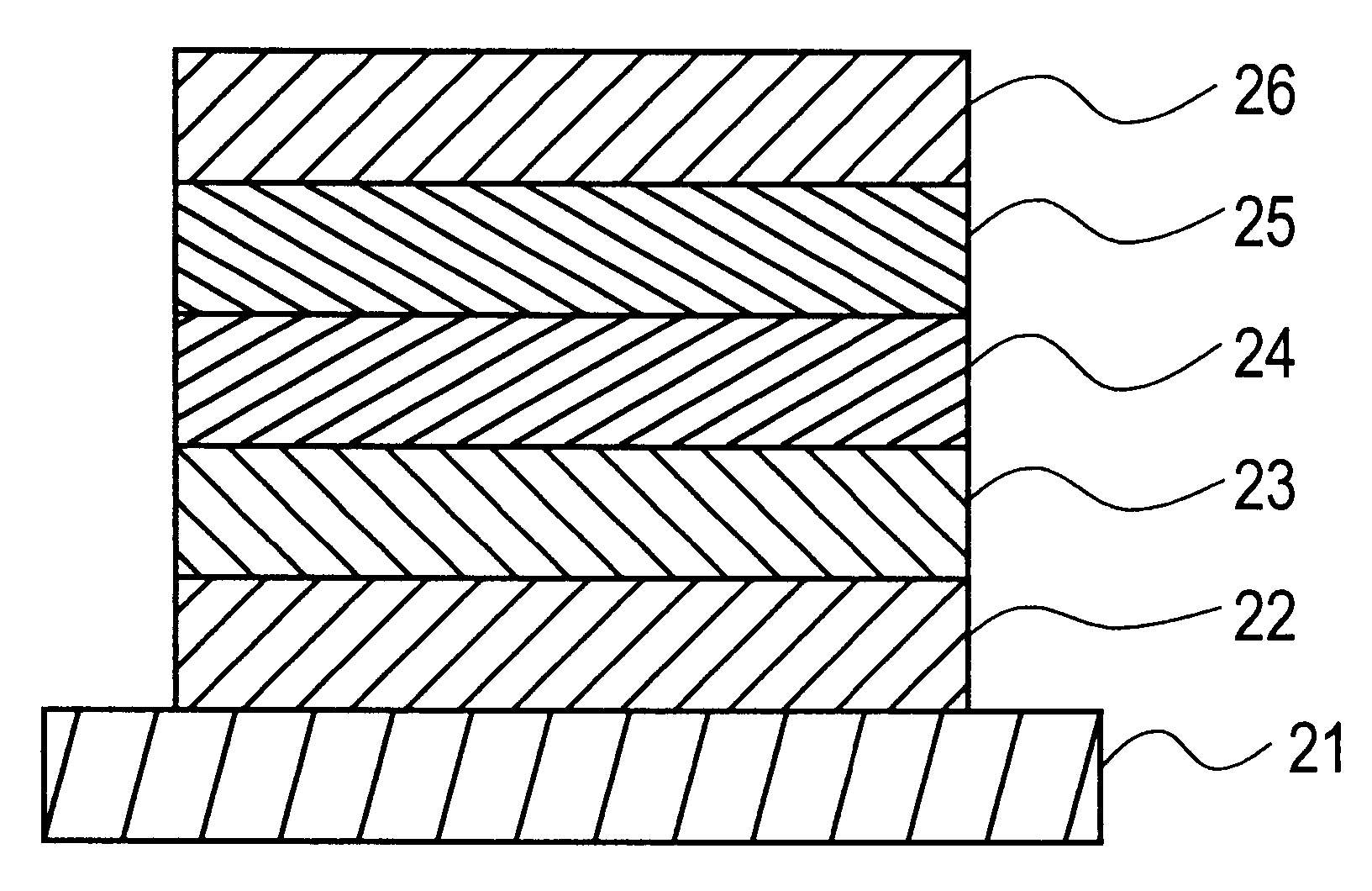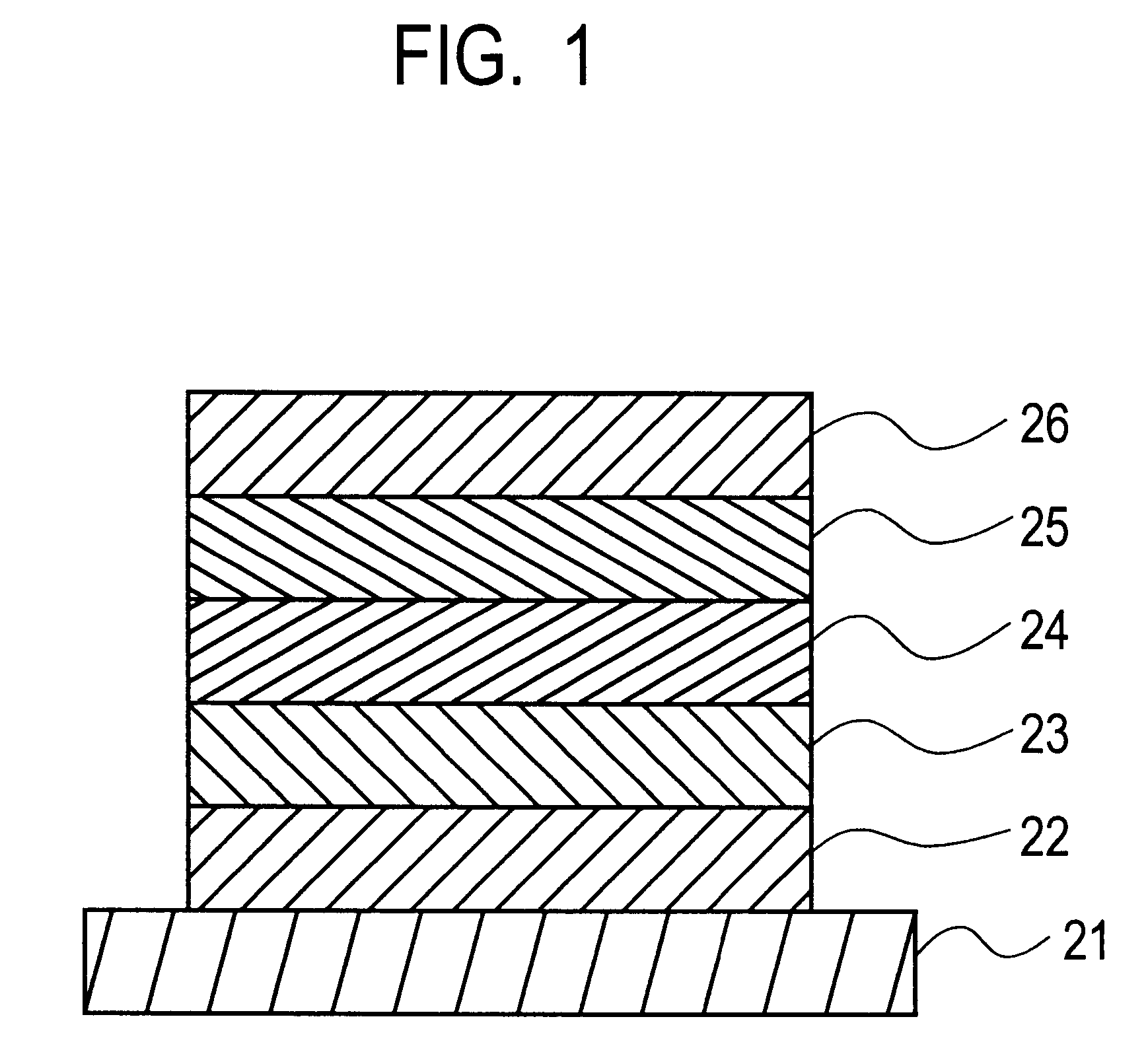Organic electroluminescent light emitting devices
a technology of electroluminescent light and electroluminescent light, which is applied in the direction of discharge tube/lamp details, discharge tube luminescnet screens, other domestic articles, etc., can solve the problems of poor adhesion of the cathode produced by such a evaporation process using resistance heating to the interface between the cathode and the organic layer, and the aforesaid stabilizing metals, too, are limited
- Summary
- Abstract
- Description
- Claims
- Application Information
AI Technical Summary
Problems solved by technology
Method used
Image
Examples
example 1
A glass substrate having a 200 nm-thick patterned ITO transparent electrode prepared by a sputtering process was ultrasonically washed with neutral detergent, acetone, and ethanol, and then pulled up from boiling ethanol, followed by drying. This transparent electrode was cleaned on its surface with UV / O.sub.3, after which the substrate was fixed to a substrate holder in a vacuum evaporation system, which was evacuated to a vacuum of 1.times.10.sup.-4 Pa or lower.
While the vacuum was maintained, N,N'-diphenyl-N,N'-m-tolyl-4,4'-diamino-1,1'-biphenyl (TPD) was evaporated at a deposition rate of 0.2 nm / sec. to a thickness of 55 nm to form a hole injecting and transporting layer.
With the vacuum still kept, Alq.sup.3 or tris(8-quinolinolato) aluminum was evaporated at a deposition rate of 0.2 nm / sec. to a thickness of 50 nm to form a light emitting and electron injecting / transporting layer.
With the vacuum still kept, this EL device structure substrate was then transferred from the vacuum...
example 2
An organic EL device was prepared by forming a cathode of 200 nm in thickness as in Example 1. However, the binary sputtering targets used were an Na.Ni target and an Al.Ta target (Ta: 2 at %), and the input power was changed with time from DC 100 to 0 W for the Na.Ni target, and from DC 0 to 500 W for the Al.Ta target.
Observation of the composition of the formed cathode film showed that much Na is present on the interface at which the cathode film is contiguous to the organic layer, with the concentration of Na decreasing gradually in the thickness-wise direction. Here, let Co represent the concentration of Na across a sectional portion of the cathode extending from the interface between the organic layer and the side of the cathode not opposite thereto to the position corresponding to one-third of the cathode thickness, and Ci denote the concentration of Na across a sectional portion of the cathode extending from the interface between the organic layer and the cathode to the posit...
example 3
An organic EL device was obtained as in Example 1, using Na.Ni, and Al.Ta targets as in Example 1. In this example, however, the Al.Ta target was used to laminate an Al.Ta thin film of 150 nm in thickness laminated on a 50 nm thick cathode formed using the Na.Ni target as in Example 1.
This organic EL device was estimated as in Example 1. As a result, it was found that the initial driving voltage drops to 8.5 V, and the half-life of light emission increases to 1,000 hours. The results are shown in Table 1.
PUM
| Property | Measurement | Unit |
|---|---|---|
| voltage | aaaaa | aaaaa |
| thickness | aaaaa | aaaaa |
| thickness | aaaaa | aaaaa |
Abstract
Description
Claims
Application Information
 Login to View More
Login to View More - R&D
- Intellectual Property
- Life Sciences
- Materials
- Tech Scout
- Unparalleled Data Quality
- Higher Quality Content
- 60% Fewer Hallucinations
Browse by: Latest US Patents, China's latest patents, Technical Efficacy Thesaurus, Application Domain, Technology Topic, Popular Technical Reports.
© 2025 PatSnap. All rights reserved.Legal|Privacy policy|Modern Slavery Act Transparency Statement|Sitemap|About US| Contact US: help@patsnap.com


